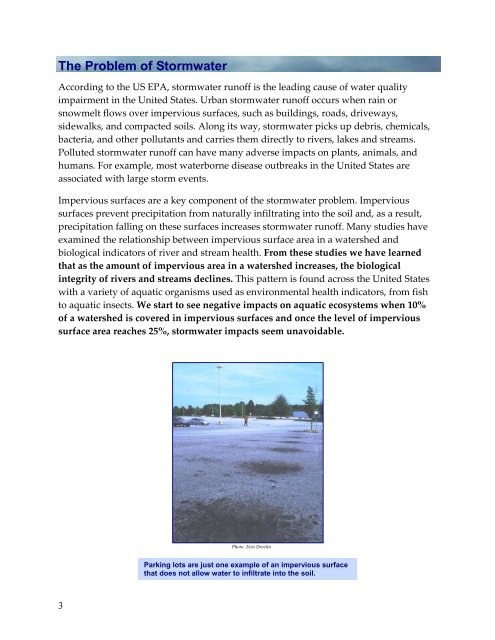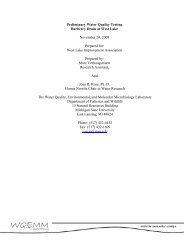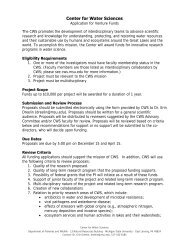Stormy Weather and Stormwater Impacts - MSU Center for Water ...
Stormy Weather and Stormwater Impacts - MSU Center for Water ...
Stormy Weather and Stormwater Impacts - MSU Center for Water ...
Create successful ePaper yourself
Turn your PDF publications into a flip-book with our unique Google optimized e-Paper software.
The Problem of <strong>Stormwater</strong><br />
According to the US EPA, stormwater runoff is the leading cause of water quality<br />
impairment in the United States. Urban stormwater runoff occurs when rain or<br />
snowmelt flows over impervious surfaces, such as buildings, roads, driveways,<br />
sidewalks, <strong>and</strong> compacted soils. Along its way, stormwater picks up debris, chemicals,<br />
bacteria, <strong>and</strong> other pollutants <strong>and</strong> carries them directly to rivers, lakes <strong>and</strong> streams.<br />
Polluted stormwater runoff can have many adverse impacts on plants, animals, <strong>and</strong><br />
humans. For example, most waterborne disease outbreaks in the United States are<br />
associated with large storm events.<br />
Impervious surfaces are a key component of the stormwater problem. Impervious<br />
surfaces prevent precipitation from naturally infiltrating into the soil <strong>and</strong>, as a result,<br />
precipitation falling on these surfaces increases stormwater runoff. Many studies have<br />
examined the relationship between impervious surface area in a watershed <strong>and</strong><br />
biological indicators of river <strong>and</strong> stream health. From these studies we have learned<br />
that as the amount of impervious area in a watershed increases, the biological<br />
integrity of rivers <strong>and</strong> streams declines. This pattern is found across the United States<br />
with a variety of aquatic organisms used as environmental health indicators, from fish<br />
to aquatic insects. We start to see negative impacts on aquatic ecosystems when 10%<br />
of a watershed is covered in impervious surfaces <strong>and</strong> once the level of impervious<br />
surface area reaches 25%, stormwater impacts seem unavoidable.<br />
Photo: Erin Dreelin<br />
Parking lots are just one example of an impervious surface<br />
that does not allow water to infiltrate into the soil.<br />
3







